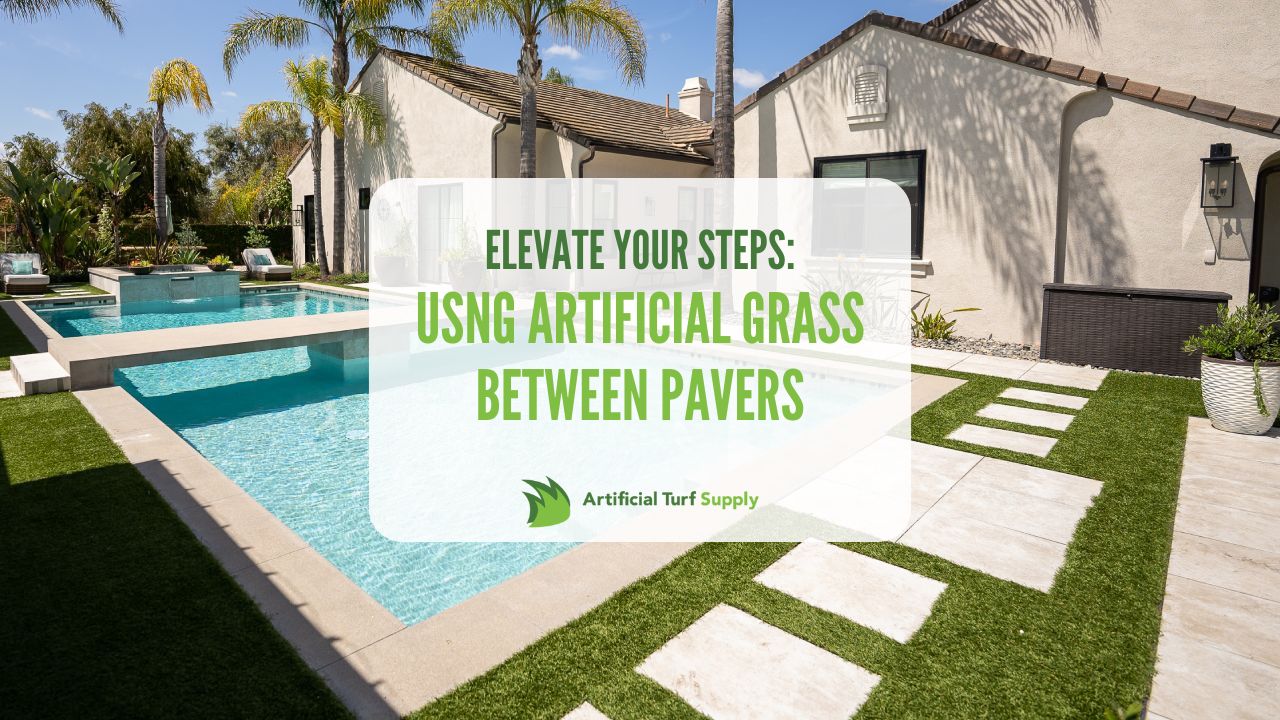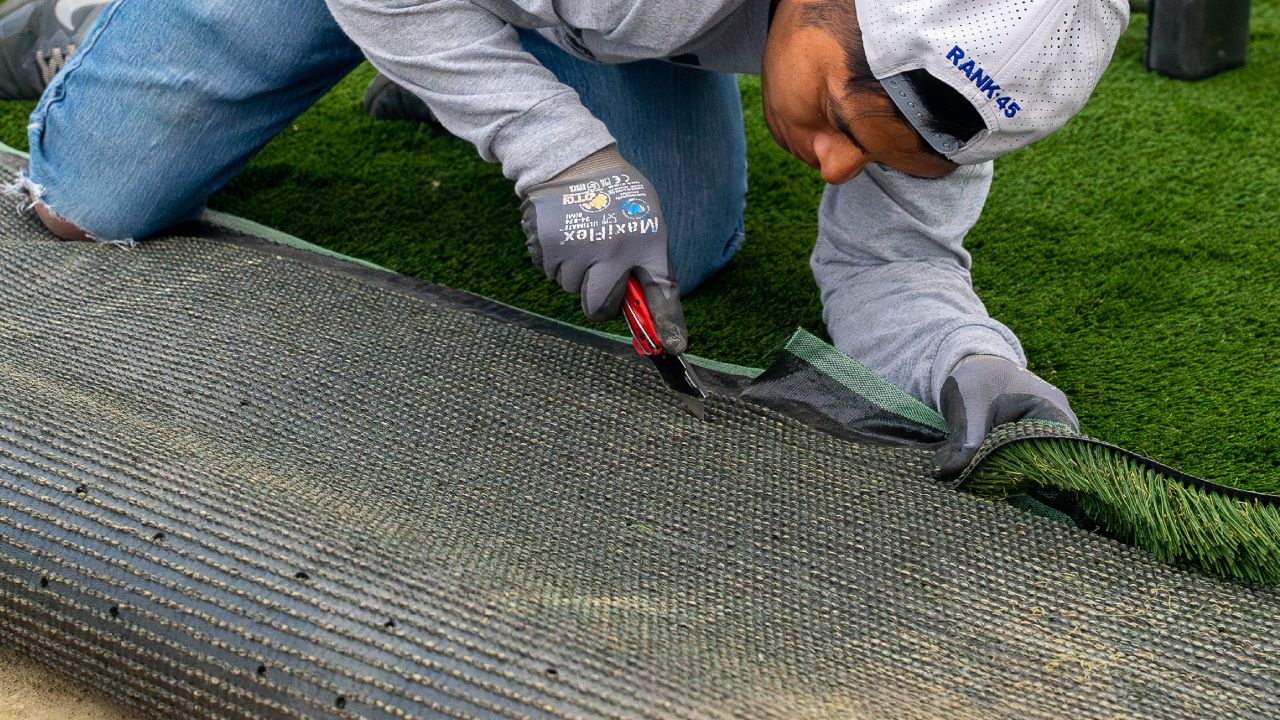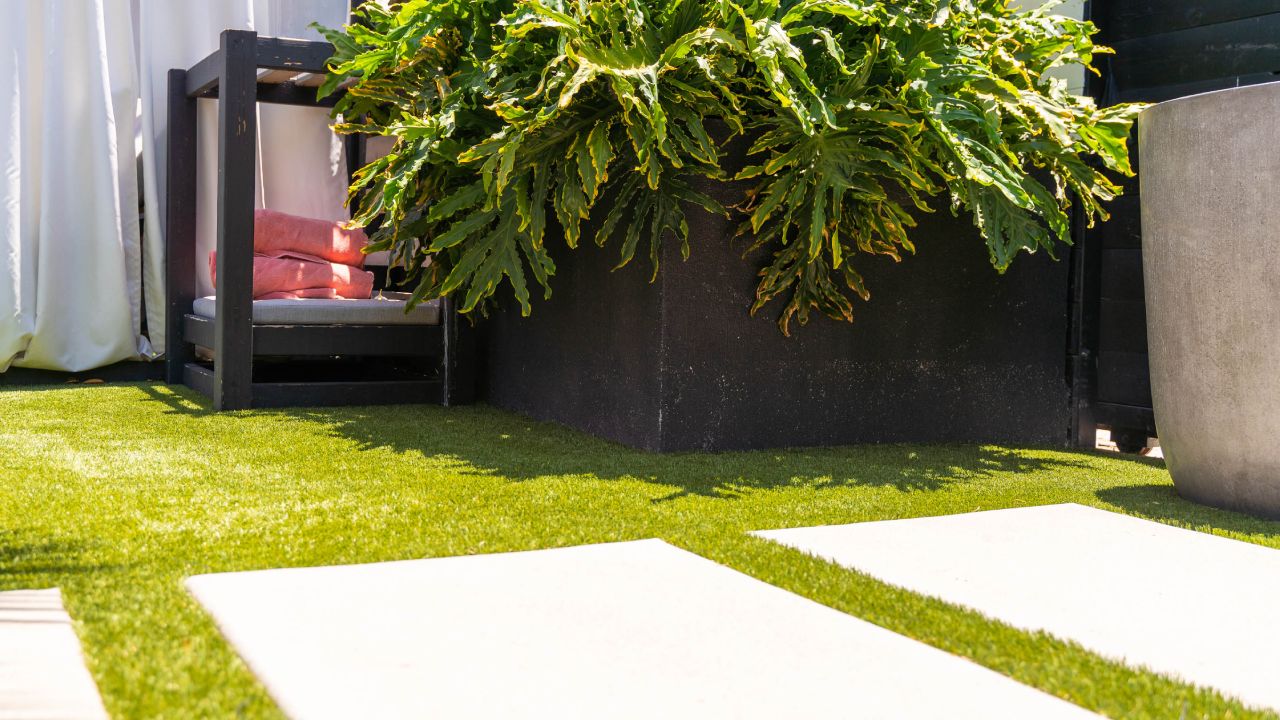Laying artificial grass between pavers is an amazingly low-maintenance way to create a sophisticated, beautiful look for your yard, garden, or courtyard. I used to be skeptical that artificial turf could be used to create these elevated outdoor looks. But the artificial grass game has come a long way, baby. Sure, real grass will always have its place for authenticity. But it’s so much effort to keep looking fresh, trimmed, and weed-free around those pavers.
So, I picked the brains of our experts at Artificial Turf Supply. Here’s everything you need to know about using turf for that picture perfect paver look.
Benefits of Artificial Grass Between Pavers
So, why choose artificial grass over other options like sand, gravel, or ground cover plants? Here are just a few of the benefits:
-
- Artificial turf stays green and pristine all year round, no matter the weather or season
- It requires zero maintenance – no mowing, watering, weeding, or feeding needed
- Fake grass provides a soft, cushioned surface that’s comfortable to walk and play on
- It’s durable and long-lasting, holding up to foot traffic and the elements
- Artificial grass is permeable, allowing water to drain through and preventing puddles
- It’s an eco-friendly choice that conserves water and eliminates the need for fertilizers and pesticides
Sounds pretty great, right? Trust me, the beauty and convenience of laying artificial grass between your pavers is a major quality of life improvement. You’ll wonder how you ever lived without it.
Choosing the Right Artificial Grass for Pavers
So, you green-light artificial turf for your pavers. Now you need to decide which type of turf is best for you. And like any other product out there, not all artificial grass is created equal. Here are a few key things to keep in mind as you make this important decision:
-
- Pile height: For a seamless look, choose a shorter pile height that won’t exceed the thickness of your pavers
- Color: Look for turf with a mix of blade colors and brown thatch for a realistic appearance
- Durability: You want a high-quality, resilient turf that can handle heavy foot traffic
- Infill: Consider the type of infill needed to weigh down the grass and provide stability
I personally love a multi-toned, low-pile turf with a soft, natural foot-feel. It blends in perfectly with my stone pavers. And it looks really convincing. Even I sometimes forget it’s not real grass!
Preparing the Paver Surface
Now you have some prep work to do before you can roll out that beautiful turf. Start off by making sure your paver surface is clean and level. And clear it of any debris or weeds. If you’re working with dirt or sand between the pavers, you’ll want to excavate a few inches to make room for a sturdy base layer.
Proper drainage is really important. Your base layer is dictates that. And the base layer also prevents the turf from shifting or sinking over time. Uneven turf between your pavers is not a good look. I recommend using class II road base or decomposed granite, compacted to create a smooth, even surface. If drainage issues do show up, tackle them ASAP. You may need to drill holes in the pavers or install a drainage system to keep water from pooling on top of the turf.
This isn’t an issue you can really ignore. Take the time to properly prep your paver base. It’ll pay off big-time in the long-run. Save future-you some headaches!
Watch and learn how to rough grade your artificial turf sub base and how to fine grade your artificial turf sub base at our How To Center.
Installation Methods for Artificial Grass and Pavers
This part of the process is when it gets real… and really fun. Installing that gorgeous turf! You can actually see your outdoor vision coming to life here, folks. You have a couple different methods, depending on the size and layout of your paver space.
First let’s talk about smaller areas. You can just cut strips of turf to fit between the pavers. Then secure them with landscape staples or adhesive. Be sure to leave a slight gap around the edges to account for expansion and contraction.
But what if you have a larger space? You may want to lay the turf over the entire surface and cut out holes for the pavers. This way you get a seamless look that eliminates any visible seams between your turf strips. This does require some precision. So be patient.
Take your time. Pay attention to the details. Make sure the turf fibers are all facing the same direction, brush in the infill evenly, and secure the edges thoroughly. You don’t want to see any curling or lifting in that beautiful turf you just bought.
Learn more: How to Install Artificial Turf for the Perfect Lawn
Cutting and Fitting Artificial Grass to Paver Spaces
So, a bit of transparency. Cutting artificial grass to fit around pavers can be a bit tedious. I’m not the most patient guy with some types of projects. But it’s important in this situation. With the right tools and a little patience, you can achieve a clean, professional look.
A sharp utility knife is your best friend for trimming turf. Use a straightedge or template to guide your cuts. And replace the blade often. Dull blades are more dangerous to use and are way less precise. So, what do you do about curved edges and tricky corners? Scissors can be helpful for fine-tuning the shape.
Getting that perfect fit can be tricky. Don’t worry – the turf fibers are very forgiving. A lot of those minor gaps or imperfections hide. Just be sure not to stretch the turf too tightly. That leads to puckering and wrinkles over time.
We’ll show you the four different cutting techniques to get your ATS lawn looking flawless at our How To Center!
Securing the Artificial Grass Between Pavers
Your turf is trimmed and fitted just right. Good job! Now you need to lock it in place. The last thing you want is for your beautiful grass ribbons to shift, curl, or blow away in the wind!
For turf strips laid over dirt or sand, landscape staples are an easy and effective way to secure the edges. Place them every few inches along the perimeter, hammering them flush with the turf backing.
If your pavers are set in concrete, you’ll need to use a heavy-duty outdoor adhesive to glue down the turf. Be sure to choose a product that’s rated for use with artificial grass and follow the manufacturer’s instructions for application.
I’ve worked on these projects before. And I’ve found it’s better to just use more staples or adhesive rather than less. That little extra hold goes a long way in keeping your turf looking pristine for years.
Maintaining Artificial Grass Between Pavers
One of the best things about artificial grass is how little upkeep it requires. I’ll go for low-maintenance over high-maintenance any day. So you want to say goodbye to mowing, watering, and weeding? Your turf ribbons will stay green and gorgeous with little effort.
I did say ‘little effort.’ Keeping your turf gorgeous for years requires a few simple maintenance tasks:
-
- Remove debris like leaves or twigs with a broom, rake, or leaf blower
- Rinse the turf occasionally with a hose to remove dust and refresh the fibers
- Brush the grass fibers with a stiff broom to keep them upright and fluffy
- Add infill as needed to maintain the turf’s stability and prevent matting
Your synthetic turf may get damaged or worn over time. That’s okay. And there’s usually something you can do about it. Small tears or bare spots can often be repaired by replacing just the affected section of grass (without having to redo the entire installation).
Repairing Damaged Areas
Even the highest-quality artificial grass may sustain some wear and tear over the years, especially in high-traffic areas. But don’t let a little damage discourage you – repairing turf is much easier and less expensive than replacing an entire lawn.
For small rips, holes, or burns, you can often patch the area with a piece of matching turf. Simply cut out the damaged section, trim a replacement piece to size, and secure it in place with adhesive or staples.
If the damage is more extensive, or if the turf has started to fade or flatten over time, you may need to replace a larger section. This is where having some extra turf on hand from your initial installation comes in handy.
To replace a section of grass, carefully cut out the old turf along the nearest seam or paver edge. Lay the new piece in place, making sure the fibers align with the surrounding grass, and secure the edges with staples or glue. Brush in some fresh infill, and voila – your turf will look as good as new.
Enhancing the Aesthetics with Edging Options
While artificial grass alone can make a big impact between pavers, adding some decorative edging can really take your installation to the next level.
Plastic or metal edging strips are a popular choice for creating a clean, defined border around the turf. They help contain the infill, prevent the grass from fraying, and give the installation a polished, professional look.
For a more natural aesthetic, you can also use rocks, stones, or low-profile plants to edge your turf ribbons. I love the look of a contrasting color mulch or a row of small succulents against the vibrant green of the grass.
No matter what edging style you choose, be sure to install it securely and level with the top of the turf. A well-executed border will enhance the overall appearance of your paver project and make your artificial grass look even more impressive.
Check out Wonder Edge artificial turf edging for an easy to install turf border!
Frequently Asked Questions about Artificial Grass Between Pavers
I get a lot of questions from homeowners who are considering artificial grass for their paver spaces. Here are some of the most common ones:
Q: Can I install artificial grass over existing pavers?
A: Yes, as long as the pavers are in good condition and properly leveled. You may need to remove a layer of sand or dirt between the pavers to accommodate the turf backing and infill.
Q: How long does artificial grass last between pavers?
A: With proper installation and maintenance, artificial grass can last 10-20 years or more. The key is to choose a high-quality turf and follow the manufacturer’s care instructions.
Q: Is artificial grass safe for kids and pets?
A: Absolutely! Modern artificial turf is non-toxic, hypoallergenic, and soft to the touch. It provides a clean, cushioned surface for playing and lounging, without the mud, allergens, or pests associated with natural grass.
Q: How much does it cost to install artificial grass between pavers?
A: The cost of materials and installation can vary depending on the size of your space, the type of turf you choose, and the complexity of the layout. On average, expect to pay between $8 to $20 per square foot for professional installation.
Q: Can I install artificial grass between pavers myself?
A: While it is possible to DIY an artificial grass installation, it can be challenging to achieve a seamless, professional look without the right tools and experience. If you’re unsure about your ability to tackle the project, it may be worth hiring a professional to ensure the best results.
Elevate Your Outdoor Space with Artificial Grass and Pavers
Using artificial grass between pavers is a beautiful, modern, authentic-looking solution if you follow this guide. And if you’ve still got questions about elevating your outdoor experience with turf solutions, our expert team members at Artificial Turf Supply are eager to hear from you at (866) 677-9405. Or request a free quote for your project today!





